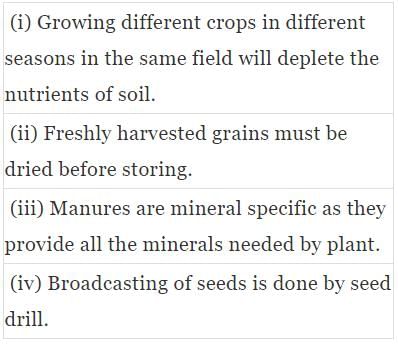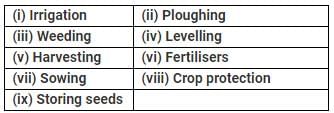Test: Crop Production & Management- 3 - Class 8 MCQ
20 Questions MCQ Test - Test: Crop Production & Management- 3
Consider the following statements and select the option which correctly identifies true (T) and false (F) ones.


Match different terms in column I with their related description in column II and select the correct option from the codes given below.


Grains are separated from stalks by a process called________
Which of the following is/are incorrect statements regarding manure?

Read the following statements and select the correct option.
Statement 1: Pheromones are used as biological method to control pest.
Statement 2: Pheromones lure adult male insects into special traps and prevent them from breeding.
Following are given the differences between manures and fertilisers. Which of the given differences are incorrect?

Pick the odd one out from each series given below and select the correct option.

Take a beaker and fill half of it with water. Put some wheat seeds in it, stir it and wait for some time. Which of the following holds true regarding the observation and inference of this experiment?
In which of the following agricultural practices, the nutrient requirements of one crop are fulfilled by the other crop?

The period of crop harvesting is celebrated with great joy and happiness in all parts of India. Special festivals are associated with the harvest season. Which among the following group of festivals is associated with harvest season?
Crop plants may be attacked by pests which affect the crop production. Fungi are such type of pests which cause diseases like
Which of the following statements are correct?

The cutting and gathering of crop after it is matured is called X. After this, grains are separated from the crop by a process called Y. Z is the process of separating the hay and chaff from the grains. Which of the following statements is/are correct regarding X, Y and Z?
A few healthy gram seeds are placed in each of the three pots X, Y and Z containing same type of soil.
The soil in pot X is mixed with some green leaves. The soil in pot Y is mixed with old cow dung while soil of pot Z is mixed with urea. Pots are watered regularly and given proper environment for plant-growth. Which of the following will be observed after 10 days?
The different steps of agricultural practices are given below randomly.

Which of the following represents the correct sequence of these practices?
The semi-arid plains of a particular region show a pattern of alternating yellow and black stripes on the ground. The yellow stripes consist of land covered by ripening wheat. The black stripes are bare soil on which no crop is grown but farmers use herbicides or tillage to remove any weeds that try to grow in that region. Why do farmers in this region manage soils in this way?
























